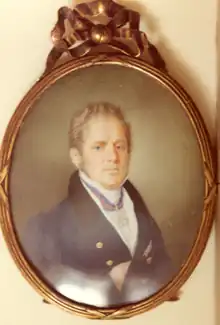Frederick Hankey (diplomat)
Sir Frederick Hankey GCMG (13 March 1774 – 13 March 1855) was a British army officer, diplomat and colonial administrator.[1] He was awarded the Grand Cross of the Order of St Michael and St George in 1833 by William IV. He served as a diplomat on Corfu and Malta.
Sir Frederick Hankey | |
|---|---|
 Portrait of Sir Frederick Hankey | |
| Chief Secretary to Government at Malta | |
| In office 1824–1837 | |
| Monarch | William IV |
| Personal details | |
| Born | 13 March 1774 London, England |
| Died | 13 March 1855 London, England |
| Awards | Knight Grand Cross of the Order of St Michael and St George |

Biography
Hankey was born in London, the third son of John Hankey, a merchant of Mincing Lane, and his wife, Elizabeth.[2][3]
Hankey married his first cousin, Charlotte Hankey, at Fetcham, Surrey, in July 1796. They had two daughters, Emma (1798-1864) and Frederica (1816-1872). Charlotte Hankey died that same year 1816.[4]
Frederick Hankey served in the British Army in Ceylon (1800-1811) as an infantry officer (he attained the rank of colonel in the 15th Regiment of Foot)[5][6]
He then became private secretary of Sir Thomas Maitland, Lord High Commissioner of the Ionian Islands and Governor of Malta, whom he had met while in Ceylon. Hankey represented Maitland (who resided in Malta) in Corfu from 1817 to 1823, thus being often incorrectly referred as "governor of the Ionian Islands".[4]
Hankey remarried in December 1818 with a woman from Corfu, Mrs Catterina (or Catherine) Valarmo, Vaslamo or Varlamo, with who he had Thomasina-Ionia (1819-1900), who married Captain Charles F. Maxwell in 1839, and Frederick (1821), who became a famour erotic writer. Catherina Valarmo died in Malta in 1835 and is buried in the Greek Orthodox cemetery there.[4][7][8]
Hankey served in Malta from 1824 to 1837.[9][10] He achieved great respect for a sensitive diplomatic mission to the Vatican about the legal immunity that the Roman Catholic Church enjoyed on the Island of Malta.[11] In particular Naples' claim that he had the right to nominate any Bishops of Malta. The Vatican would eventually come down on the side of the British, thanks in large part to Hankey's diplomatic intervention with Rome.[12]
Sir Frederick Hankey died in London in 1855[13] on his 81st birthday.
References
- The National Archives, UK. "The Discovery Service". discovery.nationalarchives.gov.uk. Retrieved 16 June 2017.
- London, England, Church of England Baptisms, Marriages and Burials, 1538–1812
- "Sir Frederick". Illustrated London News. 17 March 1855. p. 10. Retrieved 18 February 2020.
- Kearney, Patrick J. "Biographical Sketch of Frederick Hankey (1821-1882)" (PDF). Retrieved 16 June 2017.
- War Office, Great Britain (1839). "A List of the Officers of the Army and of the Corps of Royal Marines". War Office. Retrieved 16 June 2017.
- "British Infantry Regiments and the Men Who Led Them 1793-1815, Page 5" (PDF). Retrieved 16 June 2017.
- Burke, John (1838). A Genealogical and Heraldic History of the Commoners of Great Britain and Ireland, Enjoying Territorial Possessions Or High Official Rank: But Uninvested with Heritable Honours. Henry Colburn. p. 118.
sir frederick hankey.
- Potts, Jim (6 September 2013). The Ionian Islands and Epirus. Andrews UK Limited. ISBN 9781908493460. Retrieved 16 June 2017.
- "Lt Governors of Malta". Maltese History & Heritage. 18 August 2014. Retrieved 16 June 2017.
- "Malta Colony". www.britishempire.co.uk. Retrieved 16 June 2017.
- Lee, H I (1963). "British Policy towards the Religion, ancient Laws and Customs in Malta 1824-1851" (PDF). Journal of the Malta Historical Society. 3: 1–14. Retrieved 16 June 2017.
- Slade, Sir Adolphus (1837). "Turkey, Greece and Malta - Page 100". Saunders and Otley. Retrieved 16 June 2017.
- England & Wales Civil Registration Death Index 1837-1915